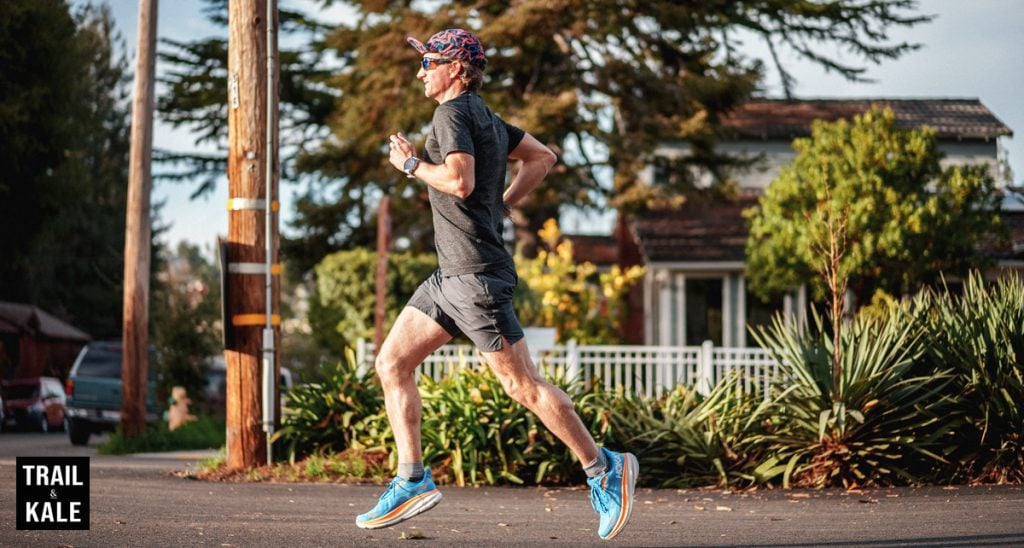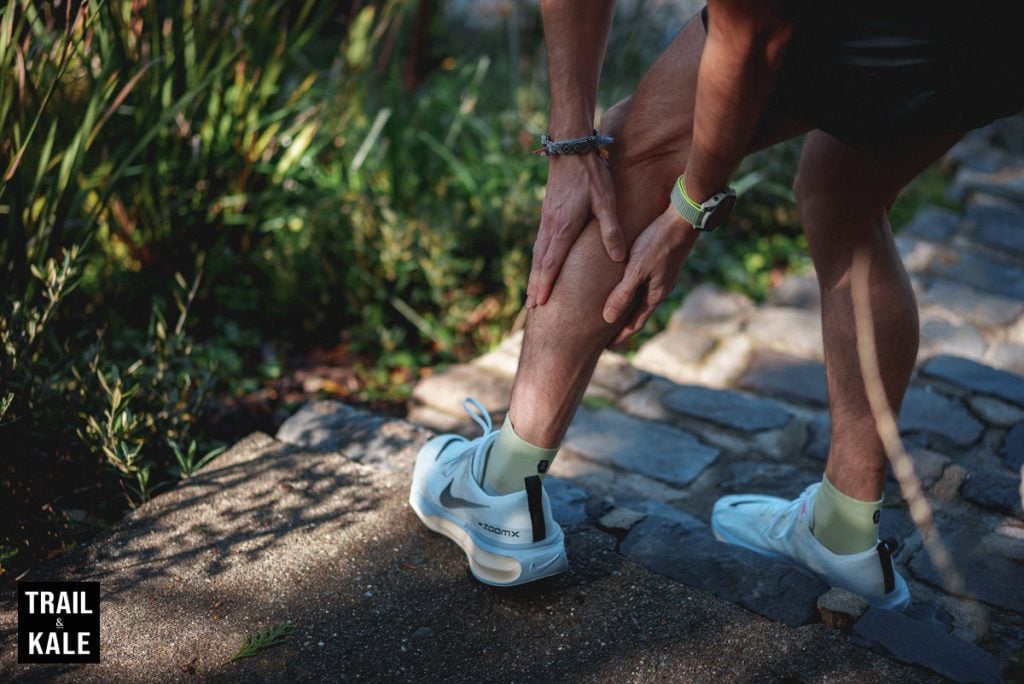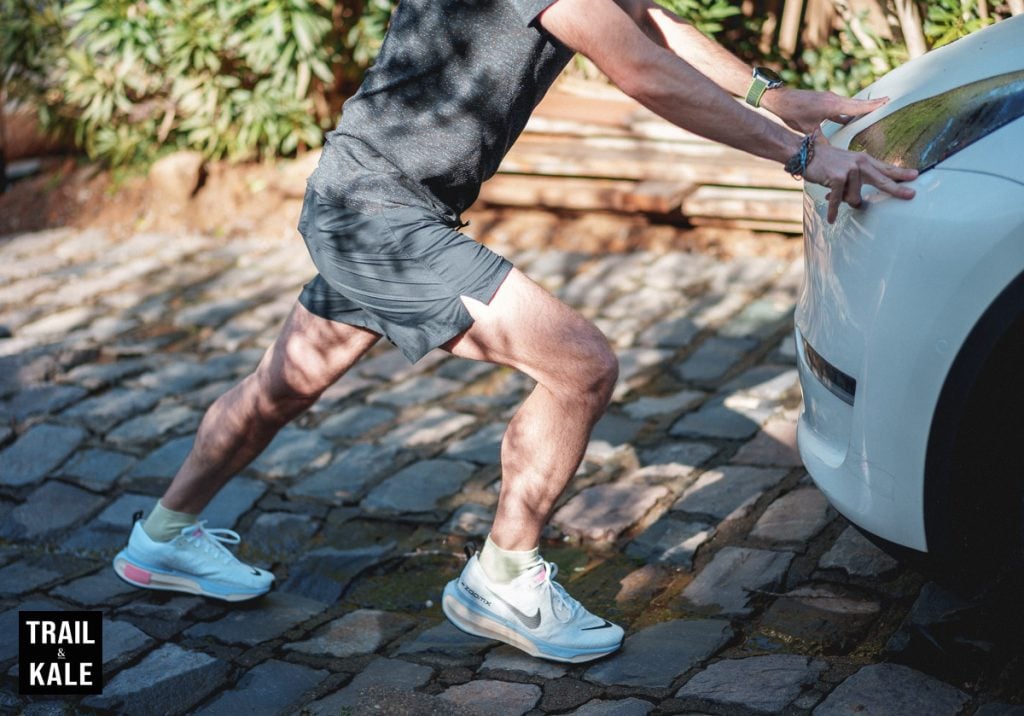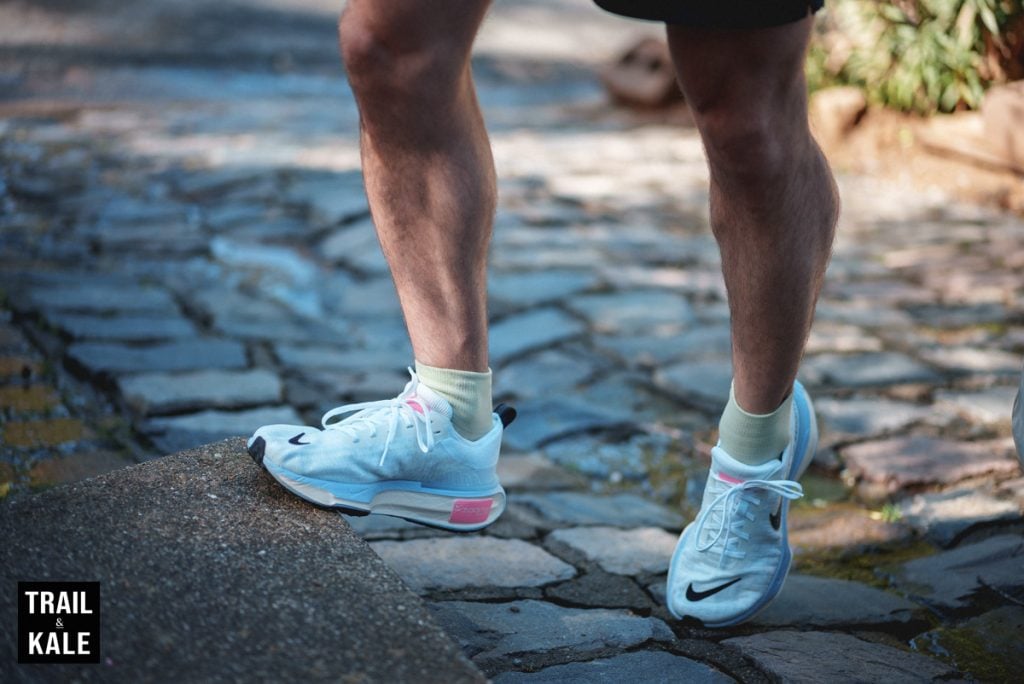Tight calves are a common issue for runners that can cause discomfort, pain, and even injury if left unaddressed. Running can place a significant amount of stress on the calves, and tightness can be caused by overuse, lack of stretching, or improper footwear.
Tight calves can also negatively impact running form, increasing your risk of running injury and decreasing performance, so it’s important to address calf tightness to prevent it from causing other, potentially more serious issues.
In this post, I explain why you may have tight calf muscles from running and share my favorite tips and stretches for preventing tight calves.

What can cause tight calves from running
Although often just referred to as your calf muscle, this ‘muscle’ is actually comprised of two primary muscles, namely the gastrocnemius (the larger, bulgy one) and the soleus muscles (a flatter muscle that lies underneath the bulge).
They converge above the heel and connect to the Achilles tendon that runs up the back of your lower leg from your heel (as shown in this picture on WebMD), so are pretty important muscles when it comes to propelling you forward and landing as you run.
Tight calves from running can be caused by a variety of factors. Six common causes are:
1. Your everyday shoes
Wearing shoes with poor support or inadequate cushioning can contribute to tight calves. This is because the muscles in your calves have to work harder to stabilize your feet and ankles, which can cause tightness and soreness.
Examples of everyday shoes that can exacerbate or cause you to have tight calves when you run are shoes with heels, as well as unsupportive pumps.
If you can, consider instead wearing some comfortable and supportive shoes every day, such as the On Cloud or Snibbs Spacecloud.

2. Poor running form and technique
Poor biomechanical running technique and running form, such as running with a cadence that is too low or with a stride length that is too long can lead to overstriding or heel striking, where your foot hits the ground in front of your center of mass.
Running with poor form can put extra strain on your calf muscles, leading to tightness and discomfort, as well as risk of other injuries such as Achilles tendinitis, plantar fasciitis, shin splints and even blisters!
3. Lack of stretching
Failing to stretch your calves before and after running can lead to tightness and stiffness.
Stretching helps improve flexibility and reduce muscle tension in your tight and sore calves.
For a list of recommended stretches to do before and after every run, plus video demonstrations, visit our guide to stretches for runners.
4. Inappropriate running shoes
Wearing shoes that are not designed for your foot type or running style can lead to overuse injuries and muscle fatigue. Shoes that are too tight or too loose are also a possible cause of your tight calves.
If you suspect it’s probably your choice of running shoes that’s a major contributor to you having tight calves when running, visit our best running shoes buyer’s guide for tips and recommendations to help you find a more suitable pair.
5. Running overuse and muscle strain
Overuse injuries, such as Achilles tendinitis or shin splints, can be caused by running with tight calves.
These injuries are typically caused by repetitive stress on the muscles and tendons in your lower legs, and can be exacerbated by running on steep hills, or running too far with more minimalist shoes than you’re used to, without building up the mileage in them gradually.
Basically, you’ve been running too much and not giving your body enough opportunity to recover and grow stronger, which is key for injury prevention.
6. Muscle cramps
If you’ve experienced cramps in your calf muscles while you’re running, you’ll know it can be very painful!
It usually feels like a sudden, sharp pain and uncontrollable contraction in the muscle, and may be caused by a lack of electrolytes (salts) during a particularly long or intense run.
It’s not unusual for your calf muscle to hurt or feel tight up to a day or more after experiencing cramps.
Learn more about the causes of leg muscle cramps and how to prevent them, and the potential benefits of drinking pickle juice for running cramp relief.
Other reasons for lower leg and calf pain in runners
It’s important to note that there could be other reasons you’re experiencing calf pain, especially if you consider it to be actual pain, rather than just tightness or having sore calf muscles.
If that’s the case, calf pain when running and pain in your calf that doesn’t go away after running could indicate a more serious issue that you may need to see a doctor or physical therapist to address.
These could include injuries such as a more severe strain, rupture or tear, so it’s always worth considering seeing an expert who can diagnose and treat your specific injury.
How to prevent sore, tight calves from happening
Here are some tips for preventing tight calves while running:
1. Warm up before running
A proper warm-up routine can help prepare your muscles for exercise and prevent tightness. Try light jogging or dynamic stretching before your run.
2. Wear proper footwear
Wearing running shoes with adequate support and cushioning can reduce the strain on your calf muscles during exercise.
3. Incorporate strength training into your routine
Exercises focused on calf strengthening such as double and single leg calf raises, lunges, and squats can help build calf strength and endurance.

4. Stretch after running
Static stretching after running can help improve flexibility and prevent you from experiencing tight calves following a run.
Specifically, stretches such as downward dog and wall stretches can be effective.
5. Rest and recovery
Resting and allowing your muscles time to recover can prevent overuse injuries and muscle fatigue.
Taking rest days and gradually increasing your mileage is important to prevent injury.
That’s why our training plans, such as our popular marathon training plans, increase weekly mileage by a maximum of only around 10% each week.

Tips for relieving tight calf muscles
Here are some tips to help release tight calves after running:
Stretching – Be sure to do regular gentle stretching, even on days you don’t run. Using a step, like pictured above, is a good way to stretch your calves after an activity.
Sports massage – If it’s an option for you, having regular sports massages will really help flush out toxins and release tight muscles.
DIY massage – Otherwise, for the price of a massage, consider getting a percussion massage gun you can use to give yourself a calf massage, and rolling tension out with a foam roller, as well as simply using your hands. Perhaps if you have a generous partner they’ll give you a calf massage (it’s worth asking?!).
Warm baths – a soak in a warm bath before stretching and massaging can help with improving flexibility and reducing tension.
Nutrition – Eating plenty of whole foods and foods with anti-inflammatory properties can help with healing sore muscles.
In summary
If you’ve been dealing with tight calves from running, I hope that the information and suggestions in this post have been helpful for you.
It’s important to address these areas of tightness when they occur, to prevent them from developing into larger issues or running injuries.
For more running tips, advice and training plans, including how to run faster, increase your VO2 max and deal with common running injuries, visit our Running 101 page!



![The Best Trail Running Shoes [2024] The Best Trail Running Shoes [2024]](https://www.trailandkale.com/wp-content/uploads/2024/02/best-trail-running-shoes-Trail-and-Kale-Recommends-2024-110x75.webp)


![14+ Best On Running Shoes [2024] Ranked With Reviews: Ultimate On Cloud Buyer’s Guide 14+ Best On Running Shoes [2024] Ranked With Reviews: Ultimate On Cloud Buyer’s Guide](https://www.trailandkale.com/wp-content/uploads/2024/05/Best-On-Running-Shoes-of-2024-110x75.webp)

